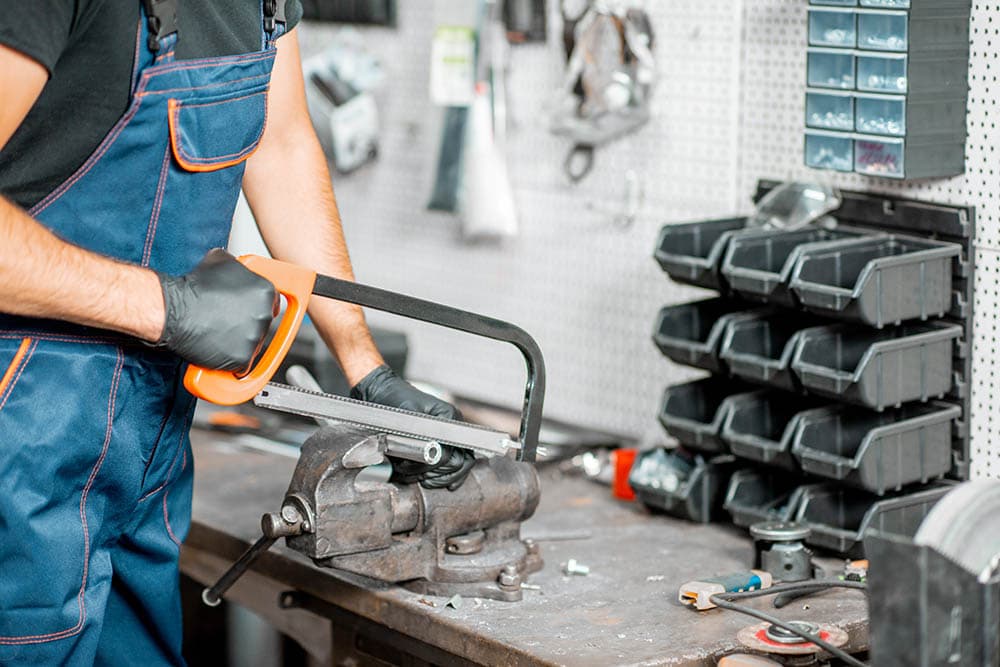7 Types of Hacksaw Frames & Blades (With Pictures)
-
Visnja Radosavljevic
- Last updated:

A hacksaw is a tool commonly used by plumbers, electricians, and DIY. Hacksaws are made of various components and depending on the type of material you’re going to cut, you can change the frame and blade to achieve better functionality.
However, some people are not familiar with all available hacksaw frames and blades, so if you’re one of them, take a look at the rest of our article. We will provide a list of seven types of hacksaw frames and blades that will help you determine which type you need to finish your project successfully.
Hacksaw Blades
First, we will talk about the available hacksaw blade options you can use.
- Blade size
- Blade nature
- The number of blade dent cuts per 1 inch
The 5 Types of Hacksaw Blades
1. Course Grade Hacksaw Blade
| Teeth per inch: | 14–18 TPI |
| Commonly used on: | Steel, copper, aluminum, brass |
The course-grade hacksaw blade is most commonly used for cutting thicker metals. Fewer TPI makes it excellent for cutting soft, thick metals like low-carbon steel, copper, brass, and aluminum. Typically, the course-grade hacksaw blade does wonders for heavy-duty cutting projects such as cutting rods and pipes. You can also use this hacksaw blade for any general workshop cutting that needs a not-so-gentle touch.
2. Medium-Grade Hacksaw Blade
| Teeth per inch: | 20–24 TPI |
| Commonly used on: | Cast iron, aluminum, high-carbon steel, Brass, copper |
The medium-grade hacksaw blade is an all-purpose blade that is an excellent choice when cutting all kinds of metal, such as copper and brass. These blades can struggle when cutting thicker metals, but they will cut the majority of metals with more grace than the course-grade hacksaw blade.
3. Fine-Grade Hacksaw Blade
| Teeth per inch: | 24–30 TPI |
| Commonly used on: | Thinner copper pipes, tubes, and sheets |
The fine-grade hacksaw blade is the perfect option for cutting thin metal and you can use it on hollow sections, sheets, thin copper pipes, thin-wall tubing, etc. It’s also suitable for electrical work because the cuts will be fine, and there will be almost no marking on the wires. It’s also an option that many plumbers use to cut plumbing joints in tight spots.
4. Superfine Grade Hacksaw Blade
| Teeth per inch: | 30–32 TPI |
| Commonly used on: | Solid metals, light metal sheets |
The superfine-grade hacksaw blade is excellent for solid metals and light metal sheets. Since this blade has a superfine grade, it doesn’t leave markings on the material when cutting. One of the types of superfine grade hacksaw blades is the AIL hard blade which is tempered and hardened to stay sharp for a long time. They are great for cutting cast iron and mold iron.
5. Flexible hacksaw blade
As the name says, the flexible hacksaw blade is flexible as the cutting teeth region of the blade is hardened and tempered so that it doesn’t become brittle. Because of that, the blade gains extra elasticity and is less likely to bend or break. They are excellent for cutting curves and rounded materials.
 The 2 Types of Hacksaw Frames
The 2 Types of Hacksaw Frames
When it comes to hacksaw frames, there are two available options—fixed hacksaw frames and adjustable hacksaw frames. Check more details about them below.
6. Fixed Hacksaw Frame
A fixed hacksaw frame is a one-piece pipe, or iron strip bent at an adequate angle to hold the blade in place. This frame type is suitable for a blade of a specific size, and it cannot be adjusted to fit blades of different lengths. Many people choose fixed hacksaw frames for their projects as they are more rigid than adjustable frames.
- Straight handle
- Pistol type handle
7. Adjustable Hacksaw Frame
An adjustable hacksaw frame is typically made of two parts, making it distinctive from the fixed frame type. You can adjust the parts to a desirable distance to fit both big and small blades of a different standard. To change the length, all you need to do is unscrew the frame screws, adjust the frame, and screw everything back in place.
- Straight handle
- Pistol-type handle
- Tubular-type handle
- Flexible Blades
The frames are commonly made of thin pipes or flat strips, and the handles are either aluminum or wood.
Tips for using a hacksaw
If you’re using a hacksaw for the first time, the process could be dangerous if you don’t know how to handle it properly. That’s why it’s helpful to know some tips and tricks to help you stay safe.
- Wear safety gear(goggles, mask, and gloves)
- During the sawing process, stay aware of sharp edges and burs
- Before selecting the blade, determine which metal you’re going to cut
- Keep the blade on the marking line
- Always keep two teeth in direct contact with the surface you’re cutting
- Keep the speed of cutting between 40 to 50 strikes per minute
- Slow down the cutting speed as you reach the end of the process
In Conclusion
Hopefully, after reading our article, you’ve a better understanding of which type of hacksaw frame and blade you need to use for your projects. Choosing an adequate blade and frame will help you perform better and finish the cutting job much easier, so remember to select them based on the material you’re cutting.
Featured Image Credit: RossHelen, Shutterstock
Contents

